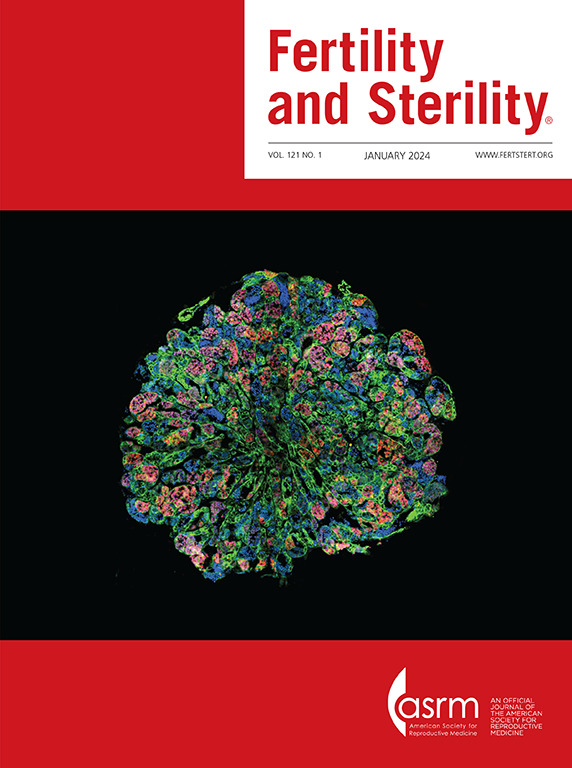评估高光谱子宫内膜分析作为子宫内膜评估的微创技术的可行性:一项初步研究(118/125个字符)。
IF 7
1区 医学
Q1 OBSTETRICS & GYNECOLOGY
引用次数: 0
摘要
目的探讨利用高光谱成像技术评估子宫内膜作为一种潜在的微创方法在同一胚胎移植周期内确定着床窗口的可行性。DESIGNProspective研究。受试者:年龄≤35岁,证明有生育能力,健康且排卵正常的志愿者,自愿同意在2021年9月至2023年2月期间在西班牙一家私人生育诊所参加研究。干预:在用人绒毛膜促性腺激素诱导和控制排卵的改良自然月经周期中捕获光谱样品。将胚胎移植导管内的微纤维镜与高光谱相机耦合引入子宫腔,以捕捉眼底水平的子宫内膜光谱。主要观察指标(S)子宫内膜高光谱可见光波长特征(在400-1,000 nm光谱范围内)被评估为识别子宫内膜分泌期分期的潜在技术。结果(S)分泌早期和中期的比较发现290个波长差异显著(占总测量数的97.3%),66个强度差异大于50%(强度比>1.5);在分泌后期和分泌中期比较,有286个波长存在显著差异(96%),其中9个波长的强度比为1.5;最后,比较分泌前期和分泌后期,发现287个波长差异显著(96.3%),69个波长差异显著,且它们之间的强度比为bbb1.5。共有26个波长被确定为一个特征,可以区分三个不同的分泌阶段。使用该特征,预测模型区分三个分泌阶段的平均准确率为87.60% (IC95%:[87.08%-88.11%]),平均AUC为79.41% (IC95%:[78.32%-80.50%])。结论(S)本研究首次证明了利用子宫内膜高光谱分析专门评估子宫内膜分泌期分子变化的可行性。因此,考虑到该技术的微创性,可以通过这种方式来区分植入窗口。需要对不孕症患者进行进一步的前瞻性研究,以评估该技术在患者分层中的临床应用。本文章由计算机程序翻译,如有差异,请以英文原文为准。
Evaluating the feasibility of hyperspectral endometrial analysis as a less invasive technique for endometrial evaluation: a pilot study (118/125 characters).
OBJECTIVE
Evaluate the feasibility of using hyperspectral imaging for endometrial evaluation as a potential minimally-invasive method to identify the window of implantation within the same embryo transfer cycle.
DESIGN
Prospective study.
SUBJECTS
Healthy and normo-ovulatory volunteers aged ≤ 35 years with proven fertility who voluntarily agreed to participate in the study between September 2021 and February 2023 at a private fertility clinic in Spain.
INTERVENTIONS
Hyperspectral samples were captured throughout a modified natural menstrual cycle in which ovulation was induced and controlled with human chorionic gonadotropin. A microfiberscope inside an embryo transfer catheter coupled with a hyperspectral camera was introduced into the uterine cavity to capture the endometrial spectra at the fundus level.
MAIN OUTCOME MEASURE(S)
The endometrial hyperspectral visible light wavelength signature (in the 400-1,000 nm spectral range) was evaluated as a potential technique to identify the endometrial secretory-phase stages.
RESULT(S)
Comparison of the early- and mid-secretory stages identified 290 significantly different wavelengths (97.3% of the total number measured), 66 with differences of more than 50% intensity (intensity ratio>1.5); in turn, the late- and mid-secretory comparison resulted in 286 significantly different wavelengths (96%), 9 of them with an intensity ratio of > 1.5 between them; finally, the comparison of the early- and late-secretory stages found in 287 significantly different wavelengths (96.3%), 69 with and intensity ratio of >1.5 between them. A total of 26 wavelengths were identified as a signature that could distinguish the three different secretory stages. Using this signature, the prediction model performance discriminated the three secretory stages with a mean accuracy of 87.60% (IC95%: [87.08%-88.11%]) and a mean AUC of 79.41% (IC95%: [78.32%-80.50%]).
CONCLUSION(S)
This present study has shown, for the first time, the feasibility of using hyperspectral endometrial analysis specifically to evaluate the molecular changes that occur in the endometrium during the secretory phase. Thus, given the minimally invasive nature of this technology, the window of implantation could be discriminated in this way. Further prospective studies with infertile patients will be required to evaluate the clinical utility of this technique in patient stratification.
求助全文
通过发布文献求助,成功后即可免费获取论文全文。
去求助
来源期刊

Fertility and sterility
医学-妇产科学
CiteScore
11.30
自引率
6.00%
发文量
1446
审稿时长
31 days
期刊介绍:
Fertility and Sterility® is an international journal for obstetricians, gynecologists, reproductive endocrinologists, urologists, basic scientists and others who treat and investigate problems of infertility and human reproductive disorders. The journal publishes juried original scientific articles in clinical and laboratory research relevant to reproductive endocrinology, urology, andrology, physiology, immunology, genetics, contraception, and menopause. Fertility and Sterility® encourages and supports meaningful basic and clinical research, and facilitates and promotes excellence in professional education, in the field of reproductive medicine.
 求助内容:
求助内容: 应助结果提醒方式:
应助结果提醒方式:


